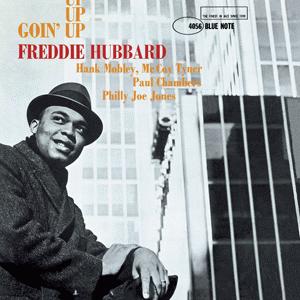Karioka – Kenny Dorham
A hard-driving medium-up composition that K.D. never recorded, Karioka comes from an early Freddie Hubbard album. A full set of parts are available for this quintet arrangement.
- Recording: Freddie Hubbard - Goin' Up
- Recorded on: November 6, 1960
- Label: Blue Note (BLP 4056)
- Concert Key: E-flat minor
- Vocal Range: , to
- Style: Swing/Latin (medium up)
- Trumpet - Freddie Hubbard
- Tenor Sax - Hank Mobley
- Piano - McCoy Tyner
- Bass - Paul Chambers
- Drums - Philly Joe Jones
0:00
0:00
Buy MP3
Video
- Description
- Historical Notes
- Solos
- Piano Corner
- Bass Corner
- Drum Corner
- Guitar Corner
- Inside & Beyond
- Minus You
This medium-up song has a real kick to it due to the varied rhythm section figures and alternation between Latin and swing sections. The intro is four measures long, with rhythm section stop-time; because there is no hit on the downbeat of the first measure, it sounds more like a three-measure intro with a pickup. The A section begins with four measures of more rhythmic melody with rhythm section figures followed by four measures of more active melody over a Latin groove. Though the next section is notated as A2, only the first four measures are like A1, with a different, simpler melody over the groove. This melody continues through 12 measures of mostly descending II-V7s, swinging with a 4-feel, leading back to a repeat of the first A section.
Much of the harmonic motion in the A sections is stepwise, with the fifth through eighth measures containing a chromatic "walk down" of E♭m chords (triad - m(maj7) - m7 - m6).
Solos are on a 28-measure form, with changes like that of the head but without the last A section. The rhythm section plays with a 4-feel throughout each solo, with a rhythmic figure in the piano each time on the last two measures. There is an interlude played at the end of each solo, a series of rhythm section figures over the A-section changes with the last two measures a break for the next soloist. Voicings for these figures are indicated in the piano part. A related figure is used to vamp and fade out for the coda.
A concert condensed score and full set of parts are available for this quintet arrangement. In the second parts, melody cues are notated below the staff where the two horn parts have counterpoint. This is especially important in the A section: both horn parts have an eighth note on the "and" of beat 4 in the first and third measures, but only the melody note leads to the downbeat on the following measures, while the second part and rhythm section hit on the "and" of beat 1.
Much of the harmonic motion in the A sections is stepwise, with the fifth through eighth measures containing a chromatic "walk down" of E♭m chords (triad - m(maj7) - m7 - m6).
Solos are on a 28-measure form, with changes like that of the head but without the last A section. The rhythm section plays with a 4-feel throughout each solo, with a rhythmic figure in the piano each time on the last two measures. There is an interlude played at the end of each solo, a series of rhythm section figures over the A-section changes with the last two measures a break for the next soloist. Voicings for these figures are indicated in the piano part. A related figure is used to vamp and fade out for the coda.
A concert condensed score and full set of parts are available for this quintet arrangement. In the second parts, melody cues are notated below the staff where the two horn parts have counterpoint. This is especially important in the A section: both horn parts have an eighth note on the "and" of beat 4 in the first and third measures, but only the melody note leads to the downbeat on the following measures, while the second part and rhythm section hit on the "and" of beat 1.
"Goin' Up" was recorded at the legendary Van Gelder Studio in Englewood Cliffs.
Like Hank Mobley, Kenny Dorham subtly tailored his compositions to the styles of others who played them. This song's driving rhythmic energy is a perfect match for the precision and excitement of Freddie Hubbard's and Philly Joe Jones' playing. "Goin' Up", Freddie's second album as a leader, contains a second K.D. song, Lotus Blossom.
November 1960 was a busy month for Freddie—a week after this session, he recorded on Hank Mobley's classic "Roll Call" album, and four days after that he played on a Randy Weston big band recording session for the album "Uhuru Afrika."
Like Hank Mobley, Kenny Dorham subtly tailored his compositions to the styles of others who played them. This song's driving rhythmic energy is a perfect match for the precision and excitement of Freddie Hubbard's and Philly Joe Jones' playing. "Goin' Up", Freddie's second album as a leader, contains a second K.D. song, Lotus Blossom.
November 1960 was a busy month for Freddie—a week after this session, he recorded on Hank Mobley's classic "Roll Call" album, and four days after that he played on a Randy Weston big band recording session for the album "Uhuru Afrika."
Related Songs
Email Send Karioka to a friend
Send this page to a friend via email. Add your name or email in the first field. In the second, add one or more email addresses, separated by a comma.

Kenny Dorham
August 30, 1924 – December 15, 1972
August 30, 2024, was Kenny Dorham's 100th birthday: jazzleadsheets.com has added 10 new K.D. compositions: K.D.News! Check them out! Kenny was inducted into the Lincoln Center Ertegun Jazz Hall of Fame On October 16, 2024, with a Tribute Concert at Dizzy's Club. Four of Kenny's daughters were in attendance. Read more...
There was a problem.
...

